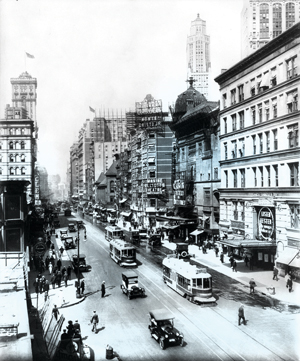Trending
This month in real estate history
Famed architecture critic bemoans gentrification, the new development advisor is born, and more…

1928: Reformer calls for city oversight of all architecture
George McAneny, a municipal reformer, civil servant and then-president of the Municipal Art Society, predicted 88 years ago this month that New York City would adopt a plan to supervise private building designs in the service of architectural beauty. Speaking at a meeting of the School Art League at the Plaza Hotel, McAneny cited Paris as an exemplar, praising the ways in which the beauty of individual buildings was enhanced by being in harmonious context with other buildings. New York had already passed its Zoning Resolution in 1916, and it went on to establish the City Planning Commission in 1936 and the Landmarks Preservation Commission in 1965. However, it has never gone as far as Paris in imposing a vision of architectural aesthetic. McAneny argued that “there are many examples of fine architecture here, which would show to their full advantage if standing alone… [whose effect is] marred by the juxtaposition of ugly and inappropriate structures.” During his career, McAneny also served as Manhattan Borough President and president of the Board of Aldermen and led the City Club of New York and the Regional Plan Association.

Ada Louise Huxtable
1969: Architecture critic laments her own lost gentrification battle
Architecture critic Ada Louise Huxtable wrote about her housing struggles in a column published in the New York Times 47 years ago this month. Huxtable, who described herself as a “bourgeois bohemian” decades before David Brooks popularized the term, admitted that she’d bought a ho-hum Park Avenue co-op in 1968 after getting evicted from the parlor floor of an elegant rent-controlled Upper East Side townhouse and priced out by a 50 percent rent hike at her next brownstone apartment. “What we have given up is the one thing that is supposed to go with New York success — choosing your own way of life,” she wrote. In Huxtable’s case, that meant living in a $200-a-month, rent-controlled brownstone floor-through with living spaces of “ballroom proportions,” three fireplaces and a small garden. She complained that “cracker boxes called luxury apartments” were replacing whole streets of brownstones — a pattern of destruction she said had transformed New York into a city you take “on its own terms now, not yours.”

Frederick Peters of Warburg Realty
1996: Brokers assume newly created role of development advisors
Developers were beginning to seek input from real estate brokers during the early stages of residential development projects, which was a new trend in the industry, the New York Times reported 20 years ago this month. Previously, the real estate agent’s role had been limited to matching buyers and sellers. The Times noted that brokers were increasingly being consulted on issues such as apartment layouts and selection of kitchen cabinets or lobby flooring. At the time, the relationship was more of a gentleman’s agreement than a legally binding contract. Brokers provided their professional opinion for free with the understanding that they would be hired to be the exclusive marketers for the apartments under development. Chris Dugan of William B. May Real Estate was reported as having advised developers who were planning to convert a Brooklyn townhouse into six residential units to make the building a condo. Meanwhile, Frederick Peters of Ashforth Warburg Real Estate (now Warburg Realty [TRDataCustom]) said agents had been invited to a lunch to look over and advise on floor plans for the residential conversion of the Mayfair Regent Hotel at 610 Park Avenue. “It’s something that’s happening all the time now,’’ Peters was quoted as saying. Today, many of New York’s large brokerage firms have new development marketing divisions.




